Quantifying Spatiotemporal Changes in Supraglacial Debris Cover in Eastern Pamir from 1994 to 2024 Based on the Google Earth Engine
Abstract
1. Introduction
2. Study Area and Dataset
2.1. Study Area
2.2. Data Sources
2.2.1. Landsat
2.2.2. Debris Supply Slope
2.2.3. Auxiliary Data
3. Methods
3.1. Preprocessing
3.1.1. Cloud Filtering
3.1.2. Image Composite
3.2. Feature Construction
3.3. RF Classification
3.3.1. RF Parameter Settings
3.3.2. Sample Selection
3.3.3. Post-Classification Processing
3.4. Accuracy Assessment and Error Analysis
4. Results and Analysis
4.1. Status of Supraglacial Debris Cover in Eastern Pamir
4.2. Changes in Supraglacial Debris Cover from 1994 to 2024
4.3. Spatial Distribution Characteristics of Supraglacial Debris Change Areas
5. Discussion
5.1. Factors Influencing Changes in Supraglacial Debris Cover
5.2. Uncertainty Analysis
5.2.1. Comparison with Previous Studies
5.2.2. Uncertainty from Glacier Terminus
6. Conclusions
Supplementary Materials
Author Contributions
Funding
Data Availability Statement
Acknowledgments
Conflicts of Interest
References
- Bolch, T. Asian glaciers are a reliable water source. Nature 2017, 545, 161–162. [Google Scholar] [CrossRef]
- Dehecq, A.; Gourmelen, N.; Gardner, A.S.; Brun, F.; Goldberg, D.; Nienow, P.W.; Berthier, E.; Vincent, C.; Wagnon, P.; Trouvé, E. Twenty-first century glacier slowdown driven by mass loss in High Mountain Asia. Nat. Geosci. 2019, 12, 22–27. [Google Scholar] [CrossRef]
- Hugonnet, R.; McNabb, R.; Berthier, E.; Menounos, B.; Nuth, C.; Girod, L.; Farinotti, D.; Huss, M.; Dussaillant, I.; Brun, F.; et al. Accelerated global glacier mass loss in the early twenty-first century. Nature 2021, 592, 726–731. [Google Scholar] [CrossRef]
- Pritchard, H.D. Asia’s shrinking glaciers protect large populations from drought stress. Nature 2019, 569, 649–654. [Google Scholar] [CrossRef] [PubMed]
- Immerzeel, W.W.; van Beek, L.P.H.; Bierkens, M.F.P. Climate Change Will Affect the Asian Water Towers. Science 2010, 328, 1382–1385. [Google Scholar] [CrossRef]
- Viviroli, D.; Archer, D.R.; Buytaert, W.; Fowler, H.J.; Greenwood, G.B.; Hamlet, A.F.; Huang, Y.; Koboltschnig, G.; Litaor, M.I.; López-Moreno, J.I.; et al. Climate change and mountain water resources: Overview and recommendations for research, management and policy. Hydrol. Earth Syst. Sci. 2011, 15, 471–504. [Google Scholar] [CrossRef]
- Zhang, Z.; Xu, J.L.; Liu, S.Y.; Guo, W.Q.; Wei, J.F.; Feng, T. Glacier changes since the early 1960s, eastern Pamir, China. J. Mt. Sci. 2016, 13, 276–291. [Google Scholar] [CrossRef]
- Zhang, Z.; Tao, P.J.; Liu, S.Y.; Zhang, S.S.; Huang, D.N.; Hu, K.H.; Lu, Y.J. What controls the surging of Karayaylak glacier in eastern Pamir? New insights from remote sensing data. J. Hydrol. 2022, 607, 12. [Google Scholar] [CrossRef]
- Ren, Z.; Su, F.G.; Xu, B.Q.; Xie, Y.; Kan, B.Y. A Coupled Glacier-Hydrology Model and Its Application in Eastern Pamir. J. Geophys. Res. Lett. Atmos. 2018, 123, 13692–13713. [Google Scholar] [CrossRef]
- Holzer, N.; Vijay, S.; Yao, T.; Xu, B.; Buchroithner, M.; Bolch, T. Four decades of glacier variations at Muztagh Ata (eastern Pamir): A multi-sensor study including Hexagon KH-9 and Pleiades data. Cryosphere 2015, 9, 2071–2088. [Google Scholar] [CrossRef]
- Lv, M.; Quincey, D.J.; Guo, H.; King, O.; Liu, G.; Yan, S.; Lu, X.; Ruan, Z. Examining geodetic glacier mass balance in the eastern Pamir transition zone. J. Glaciol. 2020, 66, 927–937. [Google Scholar] [CrossRef]
- Gardelle, J.; Berthier, E.; Arnaud, Y.; Kääb, A. Region-wide glacier mass balances over the Pamir-Karakoram-Himalaya during 1999–2011. Cryosphere 2013, 7, 1263–1286. [Google Scholar] [CrossRef]
- Kääb, A.; Treichler, D.; Nuth, C.; Berthier, E. Brief Communication: Contending estimates of 2003–2008 glacier mass balance over the Pamir-Karakoram-Himalaya. Cryosphere 2015, 9, 557–564. [Google Scholar] [CrossRef]
- Goerlich, F.; Bolch, T.; Paul, F. More dynamic than expected: An updated survey of surging glaciers in the Pamir. Earth Syst. Sci. Data 2020, 12, 3161–3176. [Google Scholar] [CrossRef]
- Kraaijenbrink, P.D.A.; Bierkens, M.F.P.; Lutz, A.F.; Immerzeel, W.W. Impact of a global temperature rise of 1.5 degrees Celsius on Asia’s glaciers. Nature 2017, 549, 257–260. [Google Scholar] [CrossRef]
- Jones, D.B.; Harrison, S.; Anderson, K.; Whalley, W.B. Rock glaciers and mountain hydrology: A review. Earth Sci. Rev. 2019, 193, 66–90. [Google Scholar] [CrossRef]
- Kirkbride, M.P.; Sherriff, S.C.; Rowan, A.V.; Egholm, D.L.; Quincey, D.J.; Miles, E.; Hubbard, B.; Miles, K. Provenance and transport of supraglacial debris revealed by variations in debris geochemistry on Khumbu Glacier, Nepal Himalaya. Earth Surf. Process. Landf. 2023, 48, 2737–2753. [Google Scholar] [CrossRef]
- van Woerkom, T.; Steiner, J.F.; Kraaijenbrink, P.D.A.; Miles, E.S.; Immerzeel, W.W. Sediment supply from lateral moraines to a debris-covered glacier in the Himalaya. Earth Surf. Dyn. 2019, 7, 411–427. [Google Scholar] [CrossRef]
- Scherler, D.; Egholm, D.L. Production and transport of supraglacial debris: Insights from cosmogenic 10Be and numerical modeling, Chhota Shigri Glacier, Indian Himalaya. J. Geophys. Res. Earth Surf. 2020, 125, 26. [Google Scholar] [CrossRef]
- Scherler, D.; Wulf, H.; Gorelick, N. Global Assessment of Supraglacial Debris-Cover Extents. Geophys. Res. Lett. 2018, 45, 11798–11805. [Google Scholar] [CrossRef]
- Jones, D.B.; Harrison, S.; Anderson, K. Mountain glacier-to-rock glacier transition. Glob. Planet. Change 2019, 181, 102999. [Google Scholar] [CrossRef]
- Xie, F.M.; Liu, S.Y.; Wu, K.P.; Zhu, Y.; Gao, Y.P.; Qi, M.M.; Duan, S.M.; Saifullah, M.; Tahir, A.A. Upward Expansion of Supra-Glacial Debris Cover in the Hunza Valley, Karakoram, During 1990~2019. Front. Earth Sci. 2020, 8, 308. [Google Scholar] [CrossRef]
- Kneib, M.; Fyffe, C.L.; Miles, E.S.; Lindemann, S.; Shaw, T.E.; Buri, P.; McCarthy, M.; Ouvry, B.; Vieli, A.; Sato, Y.; et al. Controls on Ice Cliff Distribution and Characteristics on Debris-Covered Glaciers. Geophys. Res. Lett. 2023, 50, e2022GL102444. [Google Scholar] [CrossRef]
- Buri, P.; Miles, E.S.; Steiner, J.F.; Ragettli, S.; Pellicciotti, F. Supraglacial Ice Cliffs Can Substantially Increase the Mass Loss of Debris-Covered Glaciers. Geophys. Res. Lett. 2021, 48, e2020GL092150. [Google Scholar] [CrossRef]
- Huang, L.; Li, Z.; Han, H.; Tian, B.; Zhou, J. Analysis of thickness changes and the associated driving factors on a debris-covered glacier in the Tienshan Mountain. Remote Sens. Environ. 2018, 206, 63–71. [Google Scholar] [CrossRef]
- Zhang, Y.; Fujita, K.; Liu, S.Y.; Liu, Q.; Nuimura, T. Distribution of debris thickness and its effect on ice melt at Hailuogou glacier, southeastern Tibetan Plateau, using in situ surveys and ASTER imagery. J. Glaciol. 2011, 57, 1147–1157. [Google Scholar] [CrossRef]
- Benn, D.I.; Bolch, T.; Hands, K.; Gulley, J.; Luckman, A.; Nicholson, L.I.; Quincey, D.; Thompson, S.; Toumi, R.; Wiseman, S. Response of debris-covered glaciers in the Mount Everest region to recent warming, and implications for outburst flood hazards. Earth Sci. Rev. 2012, 114, 156–174. [Google Scholar] [CrossRef]
- Juen, M.; Mayer, C.; Lambrecht, A.; Han, H.; Liu, S. Impact of varying debris cover thickness on ablation: A case study for Koxkar Glacier in the Tien Shan. Cryosphere 2014, 8, 377–386. [Google Scholar] [CrossRef]
- Huo, D.; Bishop, M.P.; Bush, A.B.G. Understanding Complex Debris-Covered Glaciers: Concepts, Issues, and Research Directions. Front. Earth Sci. 2021, 9, 652279. [Google Scholar] [CrossRef]
- Pope, A.; Rees, W.G. Impact of spatial, spectral, and radiometric properties of multispectral imagers on glacier surface classification. Remote Sens. Environ. 2014, 141, 1–13. [Google Scholar] [CrossRef]
- Bishop, M.P.; Shroder, J.F.; Ward, J.L. SPOT multispectral analysis for producing supraglacial debris-load estimates for Batura glacier, Pakistan. Geocarto Int. 1995, 10, 81–90. [Google Scholar] [CrossRef]
- Bishop, M.P.; Shroder Jr, J.F.; Hickman, B.L. SPOT Panchromatic Imagery and Neural Networks for Information Extraction in a Complex Mountain Environment. Geocarto Int. 1999, 14, 19–28. [Google Scholar] [CrossRef]
- Racoviteanu, A.; Williams, M.W. Decision Tree and Texture Analysis for Mapping Debris-Covered Glaciers in the Kangchenjunga Area, Eastern Himalaya. Remote Sens. 2012, 4, 3078–3109. [Google Scholar] [CrossRef]
- Bolch, T.; Buchroithner, M.F.; Kunert, A.; Kamp, U. Automated delineation of debris-covered glaciers based on ASTER data. In GeoInformation in Europe; Gomarasca, M.A., Ed.; Millpress: Rotterdam, The Netherlands, 2007; pp. 403–410. [Google Scholar]
- Bhambri, R.; Bolch, T.; Chaujar, R.K. Mapping of Debris-covered glaciers in the Garhwal Himalayas using ASTER DEMs and thermal data. Int. J. Remote Sens. 2011, 32, 8095–8119. [Google Scholar] [CrossRef]
- Bhardwaj, A.; Joshi, P.K.; Snehmani; Singh, M.K.; Sam, L.; Gupta, R.D. Mapping debris-covered glaciers and identifying factors affecting the accuracy. Cold Reg. Sci. Technol. 2014, 106–107, 161–174. [Google Scholar] [CrossRef]
- Yang, X.; Xie, F.M.; Liu, S.Y.; Zhu, Y.; Fan, J.H.; Zhao, H.L.; Fu, Y.Y.; Duan, Y.P.; Fu, R.; Guo, S.Y. Mapping Debris-Covered Glaciers Using High-Resolution Imagery (GF-2) and Deep Learning Algorithms. Remote Sens. 2024, 16, 2062. [Google Scholar] [CrossRef]
- Kaushik, S.; Singh, T.; Bhardwaj, A.; Joshi, P.K.; Dietz, A.J. Automated Delineation of Supraglacial Debris Cover Using Deep Learning and Multisource Remote Sensing Data. Remote Sens. 2022, 14, 1352. [Google Scholar] [CrossRef]
- Lu, Y.J.; Zhang, Z.; Shangguan, D.H.; Yang, J.H. Novel Machine Learning Method Integrating Ensemble Learning and Deep Learning for Mapping Debris-Covered Glaciers. Remote Sens. 2021, 13, 2595. [Google Scholar] [CrossRef]
- Xie, F.; Liu, S.; Gao, Y.; Zhu, Y.; Wu, K.; Qi, M.; Duan, S.; Tahir, A. Derivation of supraglacial debris cover by machine learning algorithms on the GEE platform: A case study of glaciers in the Hunza Valley. Int. Arch. Photogramm. Remote Sens. Spatial Inf. Sci. 2020, V-3-2020, 417–424. [Google Scholar] [CrossRef]
- Li, Z.J.; Wang, N.L.; Chen, A.N.; Liang, Q.; Yang, D.Q. Slight change of glaciers in the Pamir over the period 2000–2017. Arct. Antarct. Alp. Res. 2022, 54, 13–24. [Google Scholar] [CrossRef]
- Huang, D.N.; Zhang, Z.; Jiang, L.; Zhang, R.; Lu, Y.J.; Shahtahmassebi, A.; Huang, X.L. Variability of Glacier Velocity and the Influencing Factors in the Muztag-Kongur Mountains, Eastern Pamir Plateau. Remote Sens. 2023, 15, 620. [Google Scholar] [CrossRef]
- Wilkerson, F.D.; Schmid, G.L. Distribution of debris flows in Glacier National Park, Montana, USA. J. Mt. Sci. 2008, 5, 318–326. [Google Scholar] [CrossRef]
- Nagai, H.; Fujita, K.; Nuimura, T.; Sakai, A. Southwest-facing slopes control the formation of debris-covered glaciers in the Bhutan Himalaya. Cryosphere 2013, 7, 1303–1314. [Google Scholar] [CrossRef]
- Anderson, L.S.; Anderson, R.S. Modeling debris-covered glaciers: Response to steady debris deposition. Cryosphere 2016, 10, 1105–1124. [Google Scholar] [CrossRef]
- Kirkbride, M.P.; Deline, P. The formation of supraglacial debris covers by primary dispersal from transverse englacial debris bands. Earth Surf. Process. Landf. 2013, 38, 1779–1792. [Google Scholar] [CrossRef]
- McCarthy, M.; Miles, E.; Kneib, M.; Buri, P.; Fugger, S.; Pellicciotti, F. Supraglacial debris thickness and supply rate in High-Mountain Asia. Commun. Earth Environ. 2022, 3, 269. [Google Scholar] [CrossRef]
- Ouyang, Z.D.; Zhou, C.; Xie, J.; Zhu, J.J.; Zhang, G.; Ao, M.S. SRTM DEM Correction Using Ensemble Machine Learning Algorithm. Remote Sens. 2023, 15, 3946. [Google Scholar] [CrossRef]
- Liu, S.; Yao, X.; Guo, W.; Xu, J.; Shangguan, D.; Wei, J.; Bao, W.; Wu, L. The contemporary glaciers in China based on the Second Chinese Glacier Inventory. Acta Geographica Sinica 2015, 70, 3–16. [Google Scholar] [CrossRef]
- Guo, W.Q.; Liu, S.Y.; Xu, L.; Wu, L.Z.; Shangguan, D.H.; Yao, X.J.; Wei, J.F.; Bao, W.J.; Yu, P.C.; Liu, Q.; et al. The second Chinese glacier inventory: Data, methods and results. J. Glaciol. 2015, 61, 357–372. [Google Scholar] [CrossRef]
- Hu, M.; Zhou, G.; Lv, X.; Zhou, L.; He, X.; Tian, Z. A New Automatic Extraction Method for Glaciers on the Tibetan Plateau under Clouds, Shadows and Snow Cover. Remote Sens. 2022, 14, 3084. [Google Scholar] [CrossRef]
- Liao, H.; Liu, Q.; Zhong, Y.; Lu, X. Supraglacial debris-cover change and its spatial heterogeneity in the Mount Gongga, 1990–2019. Acta Geographica Sinica 2021, 76, 2647–2659. [Google Scholar] [CrossRef]
- Zhang, J.; Jia, L.; Menenti, M.; Zhou, J.; Ren, S. Glacier Area and Snow Cover Changes in the Range System Surrounding Tarim from 2000 to 2020 Using Google Earth Engine. Remote Sens. 2021, 13, 5117. [Google Scholar] [CrossRef]
- Alifu, H.; Vuillaume, J.F.; Johnson, B.A.; Hirabayashi, Y. Machine-learning classification of debris-covered glaciers using a combination of Sentinel-1/-2 (SAR/optical), Landsat 8 (thermal) and digital elevation data. Geomorphology 2020, 369, 107365. [Google Scholar] [CrossRef]
- Breiman, L. Random Forests. Mach. Learn. 2001, 45, 5–32. [Google Scholar] [CrossRef]
- Hu, M.C.; Zhou, G.S.; Lv, X.M.; Zhou, L.; Wang, X.L.; He, X.H.; Tian, Z.H. Warming Has Accelerated the Melting of Glaciers on the Tibetan Plateau, but the Debris-Covered Glaciers Are Rapidly Expanding. Remote Sens. 2023, 15, 132. [Google Scholar] [CrossRef]
- Gislason, P.O.; Benediktsson, J.A.; Sveinsson, J.R. Random Forests for land cover classification. Pattern Recogn. Lett. 2006, 27, 294–300. [Google Scholar] [CrossRef]
- Lu, Y.J.; Zhang, Z.; Kong, Y.R.; Hu, K.H. Integration of optical, SAR and DEM data for automated detection of debris-covered glaciers over the western Nyainqentanglha using a random forest classifier. Cold Reg. Sci. Technol. 2022, 193, 103421. [Google Scholar] [CrossRef]
- Varatharajan, R.; Vasanth, K.; Gunasekaran, M.; Priyan, M.; Gao, X.Z. An adaptive decision based kriging interpolation algorithm for the removal of high density salt and pepper noise in images. Comput. Electr. Eng. 2018, 70, 447–461. [Google Scholar] [CrossRef]
- Cui, T.; Li, Y.K.; Yang, L.; Nan, Y.; Li, K.B.; Tudaji, M.; Hu, H.C.; Long, D.; Shahid, M.; Mubeen, A.; et al. Non-monotonic changes in Asian Water Towers’ streamflow at increasing warming levels. Nat. Commun. 2023, 14, 1176. [Google Scholar] [CrossRef]
- Anderson, L.S.; Anderson, R.S. Debris thickness patterns on debris-covered glaciers. Geomorphology 2018, 311, 1–12. [Google Scholar] [CrossRef]
- Scherler, D.; Bookhagen, B.; Strecker, M.R. Hillslope-glacier coupling: The interplay of topography and glacial dynamics in High Asia. J. Geophys. Res. Earth Surf. 2011, 116, 21. [Google Scholar] [CrossRef]
- Bernhardt, M.; Liston, G.E.; Strasser, U.; Zängl, G.; Schulz, K. High resolution modelling of snow transport in complex terrain using downscaled MM5 wind fields. Cryosphere 2010, 4, 99–113. [Google Scholar] [CrossRef]
- Humlum, O.; Christiansen, H.H.; Juliussen, H. Avalanche-derived rock glaciers in Svalbard. Permafrost Periglac. 2007, 18, 75–88. [Google Scholar] [CrossRef]
- Daanen, R.P.; Grosse, G.; Darrow, M.M.; Hamilton, T.D.; Jones, B.M. Rapid movement of frozen debris-lobes: Implications for permafrost degradation and slope instability in the south-central Brooks Range, Alaska. Nat. Hazards Earth Syst. Sci. 2012, 12, 1521–1537. [Google Scholar] [CrossRef]
- Busby, J.P.; Lee, J.R.; Kender, S.; Williamson, P.; Norris, S. Regional modelling of permafrost thicknesses over the past 130 ka: Implications for permafrost development in Great Britain. Boreas 2016, 45, 46–60. [Google Scholar] [CrossRef][Green Version]
- Watanabe, T.; Dali, L.; Shiraiwa, T. Slope denudation and the supply of debris to cones in Langtang Himal, Central Nepal Himalaya. Geomorphology 1998, 26, 185–197. [Google Scholar] [CrossRef]
- Lu, Y.J.; Zhang, Z.; Huang, D.N. Glacier Mapping Based on Random Forest Algorithm: A Case Study over the Eastern Pamir. Water 2020, 12, 3231. [Google Scholar] [CrossRef]
- Miles, K.E.; Hubbard, B.; Irvine-Fynn, T.D.L.; Miles, E.S.; Quincey, D.J.; Rowan, A.V. Hydrology of debris-covered glaciers in High Mountain Asia. Earth Sci. Rev. 2020, 207, 103212. [Google Scholar] [CrossRef]
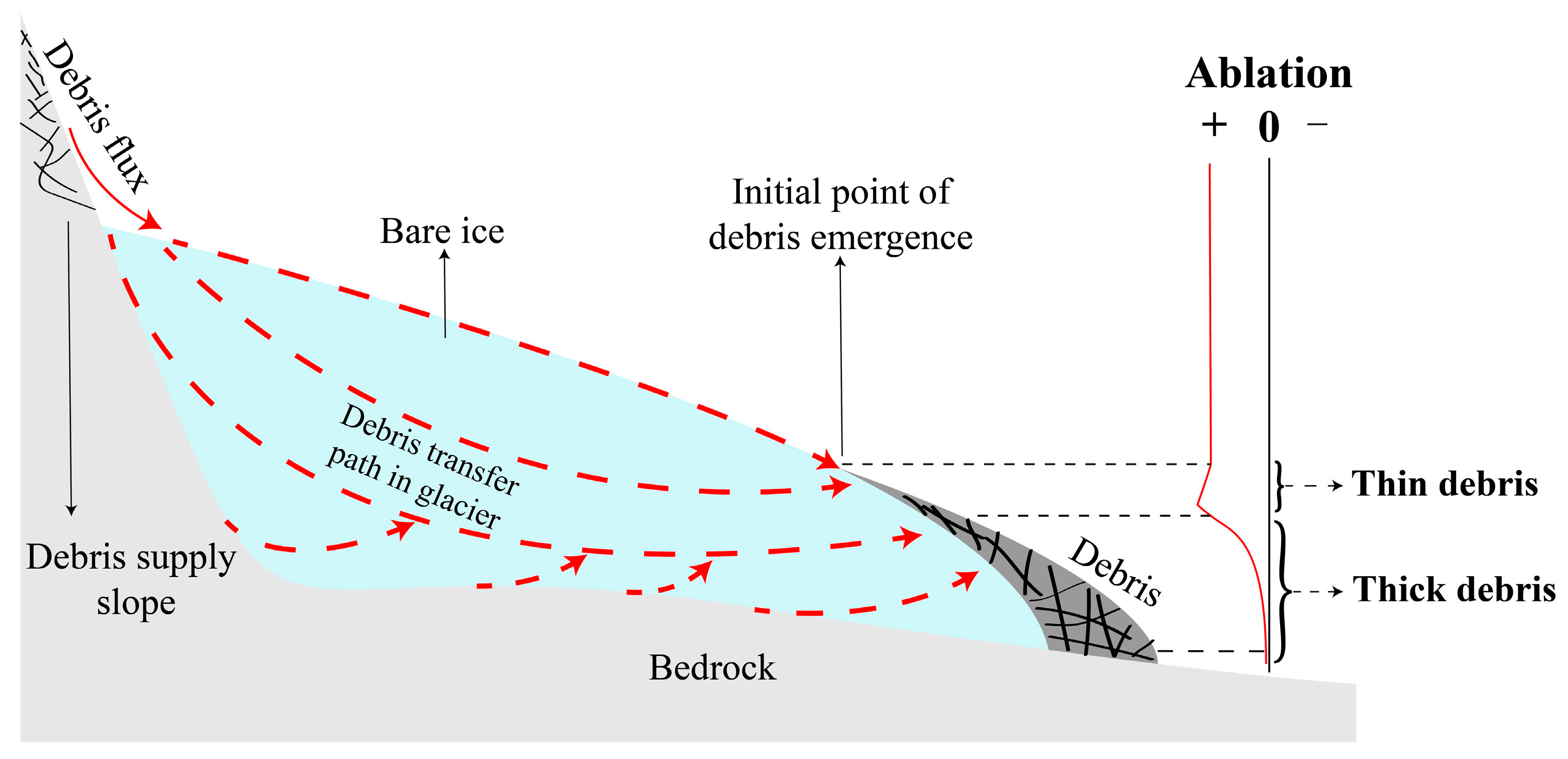

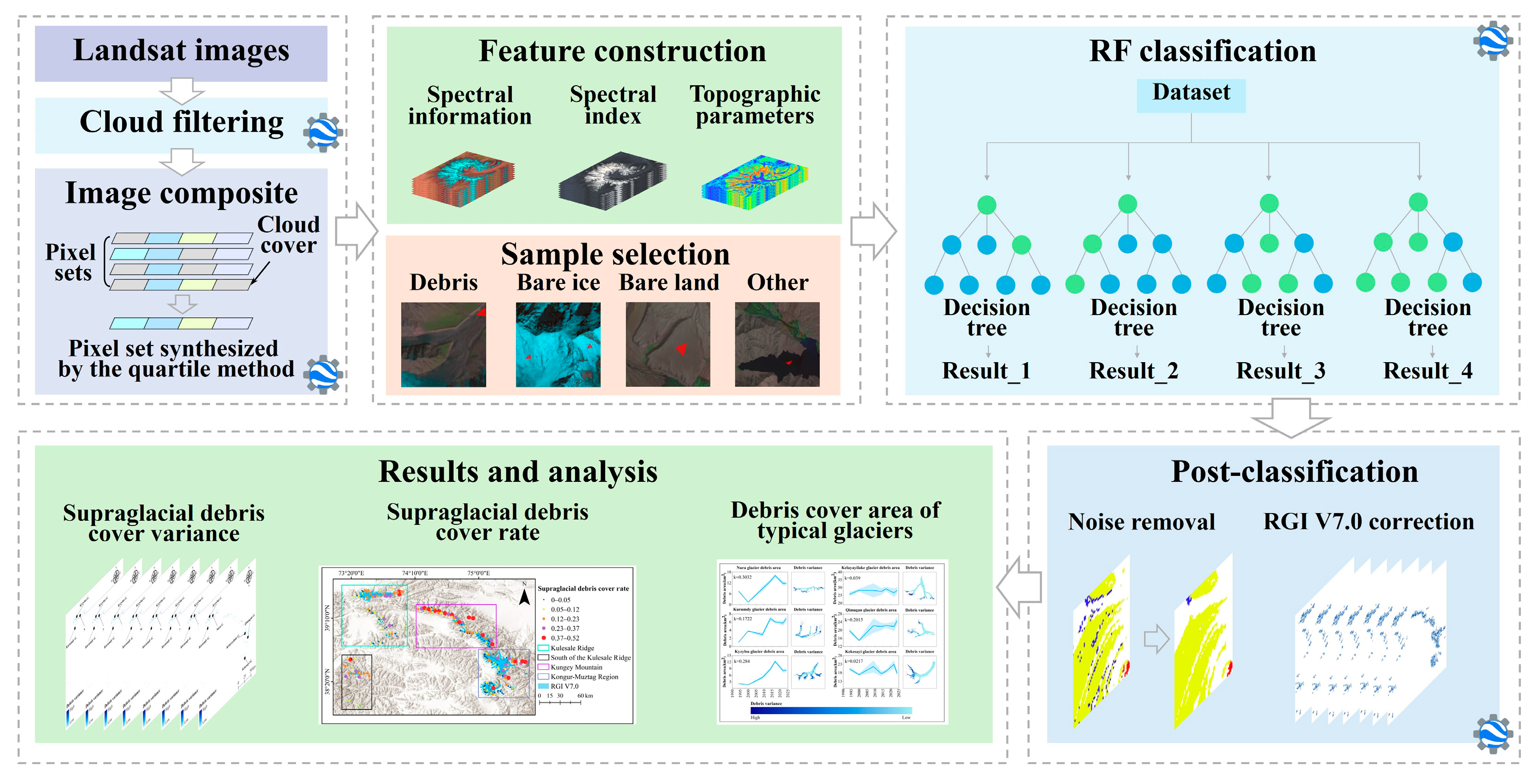
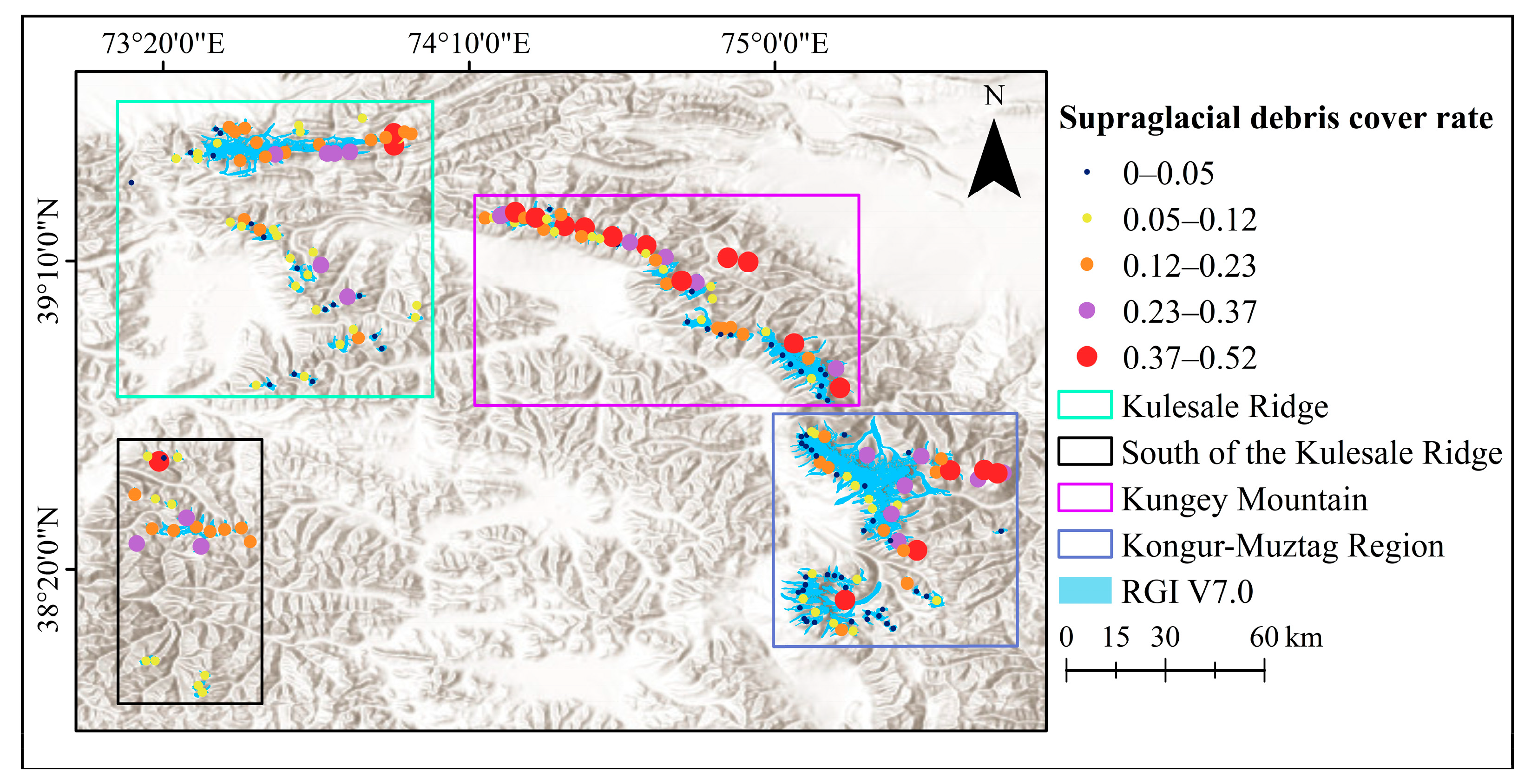

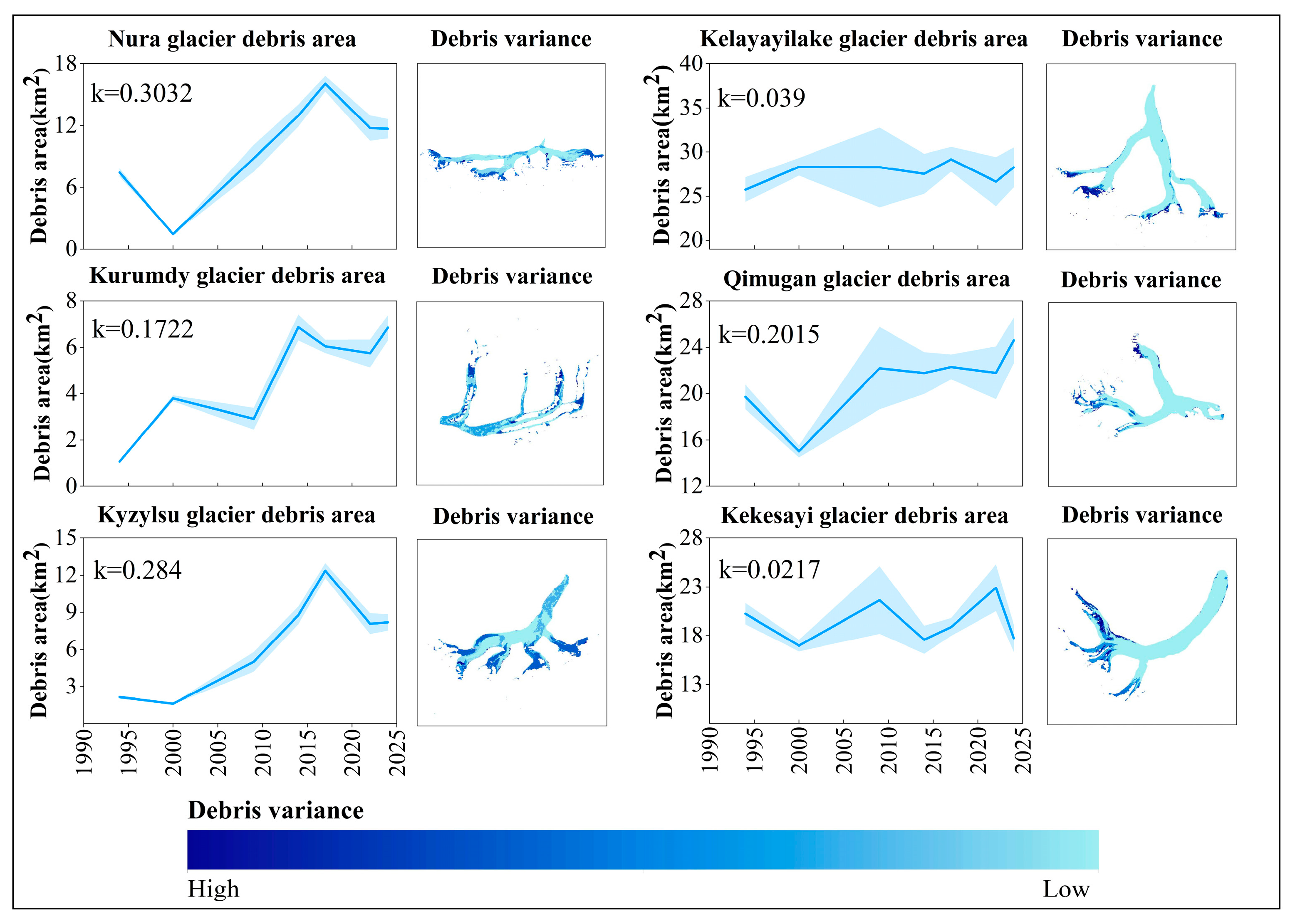

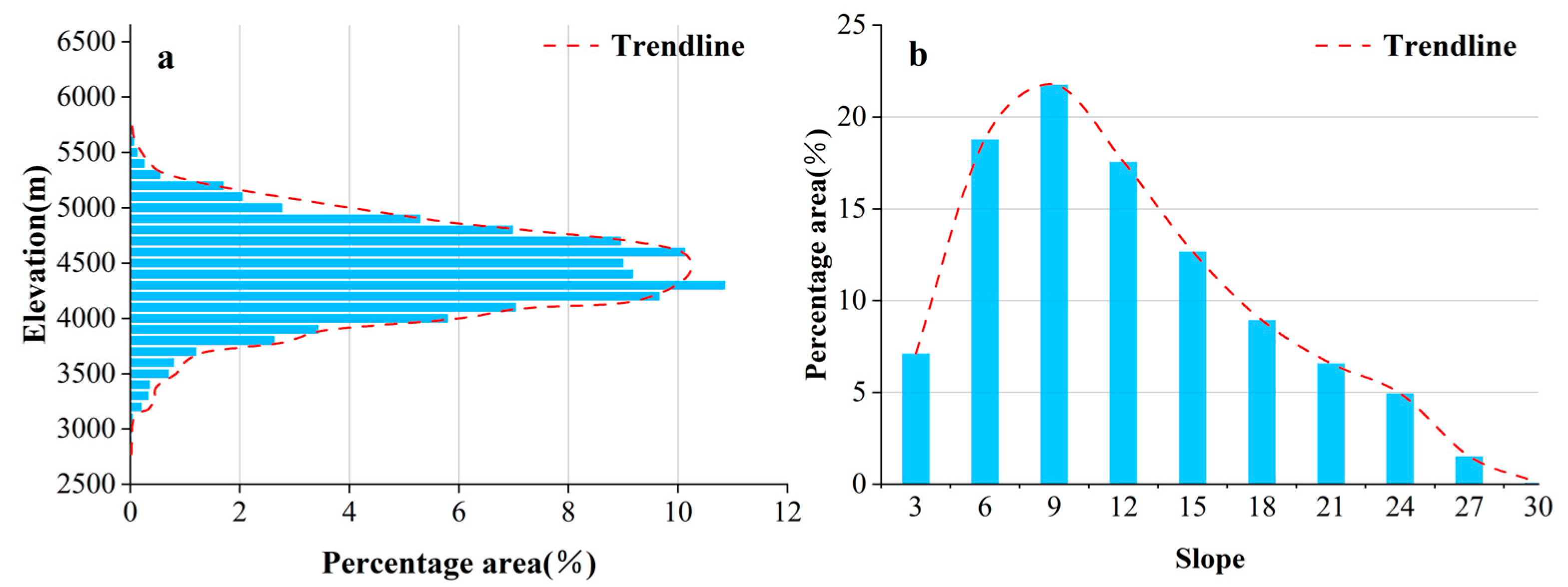
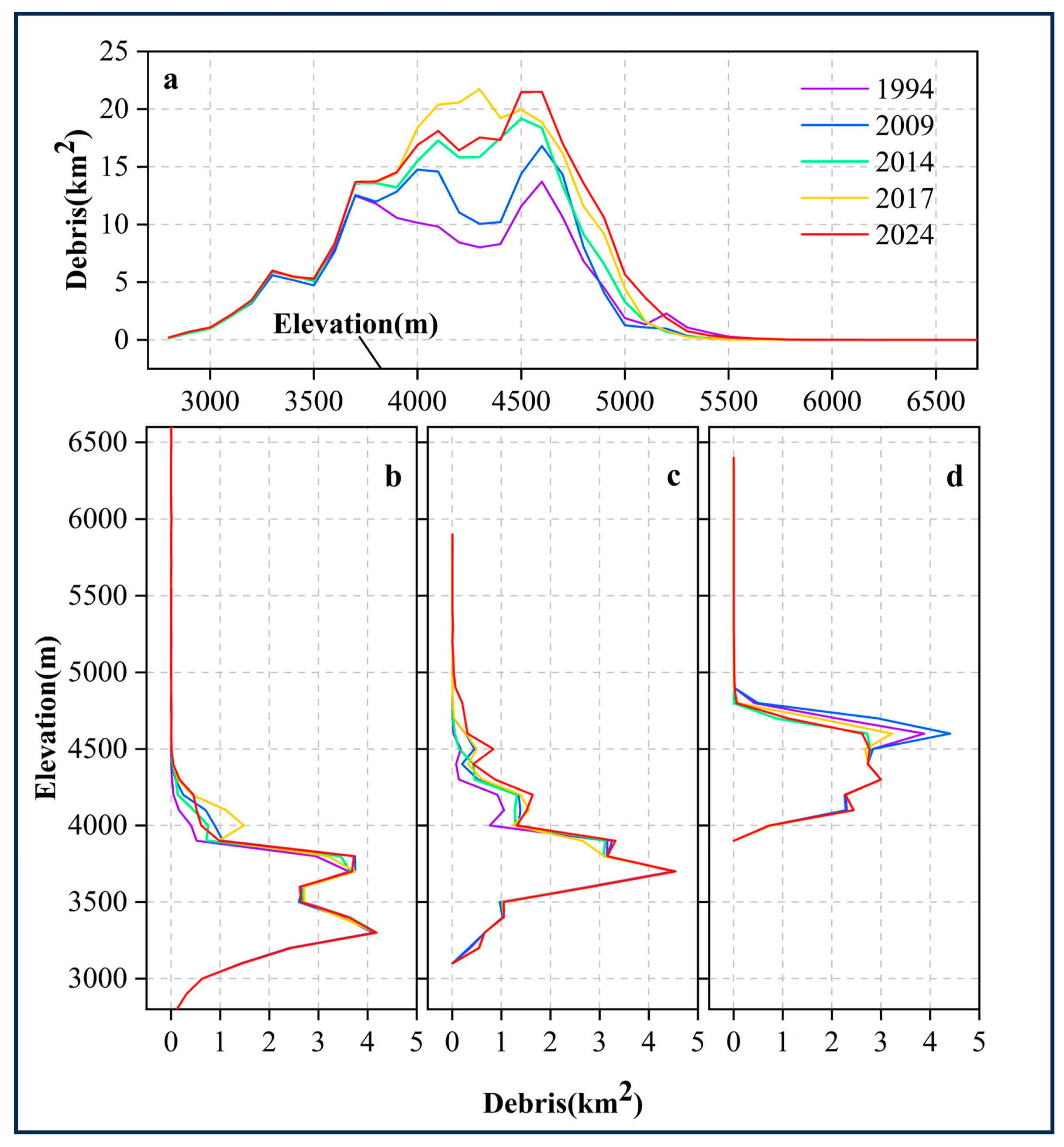


| Glacier | GLIMSId | Area (km2) | Med_ele (m) | Cen_lon (°) | Cen_lat (°) |
|---|---|---|---|---|---|
| Kyzylsu | G073544E39474N | 44.44 | 4966.72 | 73.547374 | 39.498399 |
| Nura | G073754E39483N | 53.02 | 4632.47 | 73.841405 | 39.485343 |
| Kurumdy | G073593E39445N | 40.25 | 5571.53 | 73.583934 | 39.433710 |
| Kelayayilake | G075254E38623N | 100.51 | 4961.62 | 75.173521 | 38.666799 |
| Qimugan | G075308E38567N | 75.37 | 4834.29 | 75.307523 | 38.567398 |
| Kekesayi | G075191E38250N | 45.28 | 4759.35 | 75.190512 | 38.250468 |
| Time Stage | WRS2 Path-Row | Date | LANDSAT_SCENE_ID | Sensor | Cloud Cover (%) |
|---|---|---|---|---|---|
| 1994 | 149-033 | 1 July 1994 | LT51490331994182ISP00 | TM | 1 |
| 150-033 | 6 June 1994 | LT51500331994157ISP00 | TM | 2 | |
| 151-033 | 31 July 1994 | LT51510331994212ISP01 | TM | 1 | |
| 2000 | 149-033 | 16 August 1999 | LT51490331999228AAA02 | TM | 15 |
| 150-033 | 21 May 2000 | LT51500332000142XXX02 | TM | 4 | |
| 151-033 | 10 April 2000 | LT51510332000101XXX02 | TM | 3 | |
| 2009 | 149-033 | 26 July 2009 | LT51490332009207KHC00 | TM | 2 |
| 150-033 | 1 July 2009 | LT51500332009182KHC00 | TM | 3 | |
| 151-033 | 25 August 2009 | LT51510332009237KHC00 | TM | 5 | |
| 2014 | 149-033 | 26 September 2014 | LC81490332014269LGN01 | OLI | 2.01 |
| 150-033 | 3 October 2014 | LC81500332014276LGN01 | OLI | 0.91 | |
| 151-033 | 7 October 2013 | LC81510332013280LGN01 | OLI | 0.46 | |
| 2017 | 149-033 | 19 July 2018 | LC81490332018200LGN00 | OLI | 2.47 |
| 150-033 | 9 September 2017 | LC81500332017252LGN00 | OLI | 1.21 | |
| 151-033 | 15 August 2017 | LC81510332017227LGN00 | OLI | 0.85 | |
| 2022 | 149-033 | 29 September 2021 | LC81490332021272LGN00 | OLI | 1.18 |
| 150-033 | 21 July 2022 | LC81500332022202LGN00 | OLI | 1 | |
| 151-033 | 14 September 2022 | LC81510332022257LGN00 | OLI | 1.36 | |
| 2024 | 149-033 | 21 September 2024 | LC81490332024265LGN00 | OLI | 3.64 |
| 150-033 | 12 September 2024 | LC81500332024256LGN00 | OLI | 1.23 | |
| 151-033 | 3 September 2024 | LC81510332024247LGN00 | OLI | 0.78 |
| Region | Maximum | Minimum | Average |
|---|---|---|---|
| KR | 0.41 | 0 | 0.12 |
| SKR | 0.48 | 0.03 | 0.16 |
| KM | 0.52 | 0 | 0.18 |
| KMR | 0.49 | 0 | 0.10 |
| EP | 0.52 | 0 | 0.14 |
| Time Stage | RF Model | |||
|---|---|---|---|---|
| Kappa | Overall Accuracy (%) | Bare Ice (km2) | Supraglacial Debris (km2) | |
| 1994 | 0.96 | 97.5 | 1265.85 ± 48.74 | 166.42 ± 8.94 |
| 2000 | 0.97 | 98.3 | 1019.4 ± 19.50 | 175.73 ± 6.19 |
| 2009 | 0.93 | 95.0 | 1296.23 ± 21.14 | 190.03 ± 30.50 |
| 2014 | 0.96 | 97.2 | 1098.65 ± 28.32 | 227.21 ± 18.70 |
| 2017 | 0.98 | 98.4 | 1189.16 ± 23.47 | 257.81 ± 12.43 |
| 2022 | 0.95 | 96.2 | 1178.34 ± 41.11 | 225.33 ± 23.51 |
| 2024 | 0.97 | 98.0 | 1137.24 ± 6.65 | 258.08 ± 20.65 |
Disclaimer/Publisher’s Note: The statements, opinions and data contained in all publications are solely those of the individual author(s) and contributor(s) and not of MDPI and/or the editor(s). MDPI and/or the editor(s) disclaim responsibility for any injury to people or property resulting from any ideas, methods, instructions or products referred to in the content. |
© 2025 by the authors. Licensee MDPI, Basel, Switzerland. This article is an open access article distributed under the terms and conditions of the Creative Commons Attribution (CC BY) license (https://creativecommons.org/licenses/by/4.0/).
Share and Cite
Liu, H.; Zhang, Z.; Liu, S.; Xie, F.; Ding, J.; Li, G.; Su, H. Quantifying Spatiotemporal Changes in Supraglacial Debris Cover in Eastern Pamir from 1994 to 2024 Based on the Google Earth Engine. Remote Sens. 2025, 17, 144. https://doi.org/10.3390/rs17010144
Liu H, Zhang Z, Liu S, Xie F, Ding J, Li G, Su H. Quantifying Spatiotemporal Changes in Supraglacial Debris Cover in Eastern Pamir from 1994 to 2024 Based on the Google Earth Engine. Remote Sensing. 2025; 17(1):144. https://doi.org/10.3390/rs17010144
Chicago/Turabian StyleLiu, Hehe, Zhen Zhang, Shiyin Liu, Fuming Xie, Jing Ding, Guolong Li, and Haoran Su. 2025. "Quantifying Spatiotemporal Changes in Supraglacial Debris Cover in Eastern Pamir from 1994 to 2024 Based on the Google Earth Engine" Remote Sensing 17, no. 1: 144. https://doi.org/10.3390/rs17010144
APA StyleLiu, H., Zhang, Z., Liu, S., Xie, F., Ding, J., Li, G., & Su, H. (2025). Quantifying Spatiotemporal Changes in Supraglacial Debris Cover in Eastern Pamir from 1994 to 2024 Based on the Google Earth Engine. Remote Sensing, 17(1), 144. https://doi.org/10.3390/rs17010144







